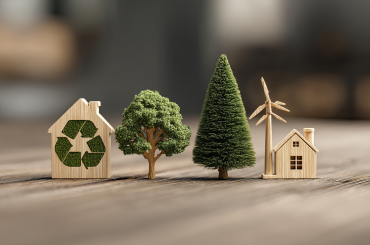Moving house makes me break out in stress hives. Not because I’m particularly attached to places—I’ve moved six times in the last decade—but because of the environmental carnage that typically accompanies relocation. Last month, I watched my neighbor move out with enough bubble wrap to mummify a small building, and I genuinely felt nauseous thinking about where all that plastic would end up.
That’s when I decided my next move absolutely had to be different. I’d been writing about sustainability for years, yet somehow I’d never properly considered how to move eco friendly without creating a landfill’s worth of waste. The irony wasn’t lost on me—here I was, preaching about environmental responsibility while planning to wrap my life in single-use materials and ship it across town in the most wasteful way possible.
The research phase nearly drove me mad. I spent three weeks investigating every aspect of eco friendly moving, from biodegradable packing materials to carbon-neutral transport options. My browser history looked like I was planning an expedition to Mars rather than relocating fifteen minutes down the road. But honestly? It was brilliant. I discovered this whole world of sustainable moving practices that nobody talks about, probably because most removal companies make their money selling you disposable packaging materials.
The first revelation came when I found a local company that rents reusable plastic crates instead of selling cardboard boxes. They drop off these sturdy, stackable containers, you pack your stuff, then they collect them after you’ve unpacked. No cardboard mountain in your new living room, no recycling guilt, and the crates actually protect your belongings better than flimsy boxes. I felt smugly superior until I realized I’d miscalculated and ordered three times as many crates as I needed—apparently I’m terrible at estimating volume.
Decluttering became the most cathartic part of the whole process. I’d been putting off sorting through five years of accumulated nonsense, but moving gave me the perfect deadline. Three bags of barely-worn clothes went to the charity shop, my collection of unused kitchen gadgets found new homes with friends who’d actually appreciate them, and I sold roughly fifty books I’d been hoarding “just in case” I wanted to reread them. Spoiler alert: I never reread books. Every item that left my house was one less thing to pack, move, and clutter up my new space with.
The packing became a exercise in creative problem-solving. Instead of buying bubble wrap, I used every towel, sheet, and item of clothing I owned as protective padding. My wine glasses traveled wrapped in winter jumpers, plates got cushioned between bath towels, and electronics nestled safely in soft scarves. It looked absolutely chaotic—like I’d just tipped my wardrobe into the crates—but nothing broke, and I didn’t need to purchase a single sheet of plastic packaging.
I discovered biodegradable packing peanuts made from cornstarch, which completely dissolved in water. These became my secret weapon for protecting delicate items, though I’ll admit I was too nervous to test the water-soluble claims with my laptop nearby. Still, knowing they wouldn’t persist in a landfill for the next millennium made the whole process feel less apocalyptic. Plus, they don’t stick to absolutely everything like those horrible polystyrene ones that seem designed to escape and colonize your entire house.
The sustainable moving tips I’d researched really came into their own during the actual packing phase. Paper tape instead of plastic, cardboard dividers instead of foam inserts, and old newspapers for wrapping small items. I felt like some sort of eco-warrior assembling an army of sustainable alternatives. The moving company loved it too—apparently the rental crates are much easier to handle than endless cardboard boxes, and my clothing-wrapped approach actually protected fragile items better than standard bubble wrap in many cases.
What surprised me most was how zero waste moving principles extended beyond just materials. I planned the move to minimize transport emissions by hiring a larger vehicle for a single journey instead of multiple trips. I scheduled it during off-peak hours to reduce traffic-related pollution and chose a local removal company to minimize travel distances. These might seem like tiny details, but they all add up when you’re trying to create a genuinely sustainable relocation.
The unpacking process became unexpectedly social because of my eco-friendly approach. Instead of drowning in cardboard and plastic waste, I had all these lovely clean towels and clothes to put away immediately. I organized an “unpacking party” where neighbors could take any items I’d decided not to keep. It was brilliant—instead of making multiple charity shop trips, I could rehome things directly to people who wanted them while getting to know my new community properly.
My friend Sarah brought homemade biscuits and stayed to help arrange furniture. We ended up having this lovely afternoon sorting through kitchen equipment and planning sustainable meal prep ideas for my new space. Moving day transformed from a stressful ordeal into an opportunity for community building, which definitely wasn’t something I’d expected when I started researching eco friendly moving tips.
The leftover newspapers I’d used for wrapping became art supplies for a children’s craft session I organized a few weeks later. We made papier-mâché planters and painted decorations for the communal garden area. Instead of going straight to recycling, those newspapers got a second life encouraging creativity. The kids taught me some brilliant origami folding techniques that I’m definitely stealing for future packing projects.
Cost-wise, sustainable moving actually worked out cheaper than I’d expected. Renting reusable crates cost less than buying equivalent cardboard boxes, and I didn’t need to purchase any packing materials since I used items I already owned. The money I saved on bubble wrap and tape went toward a celebration dinner at a local restaurant that sources ingredients sustainably. Sometimes being environmentally conscious actually saves money, which feels like winning the lottery.
Storage in my new flat became more organized because the rental crates had forced me to pack systematically. When everything has to fit in standardized containers, you can’t just throw things together randomly. I’d labeled everything clearly and packed room by room, which meant unpacking was efficient rather than chaotic. The whole experience taught me that zero waste living often involves better organization rather than just different products.
What really struck me was how eco friendly moving connected me to my new community immediately. The unpacking party, the children’s craft afternoon, conversations with neighbors about local recycling facilities—all these interactions happened because I was trying to move sustainably. Traditional moving tends to be quite isolating, but my approach created natural opportunities for social connection and environmental education.
The experience completely changed how I think about major life transitions. Moving house is this intense period where you handle literally everything you own, which forces you to confront your consumption patterns whether you want to or not. Doing it sustainably made me consider not just what I was taking to my new home, but whether I actually needed it there. The result was a much more intentional living space filled only with things I genuinely value.
Six months later, I still have some of those biodegradable packing peanuts in a jar on my kitchen counter. They’ve become conversation starters when people visit, leading to discussions about sustainable self-care and plastic alternatives that probably wouldn’t have happened otherwise. Sometimes eco-friendly choices create unexpected opportunities for spreading environmental awareness beyond your original intention.
The rental crate company contacted me recently asking if I’d recommend their service to friends, which made me realize I’d become accidentally evangelical about sustainable moving. I’ve since helped four other people plan environmentally responsible relocations, and each time we’ve refined the process slightly. Sharing knowledge about sustainable alternatives seems to multiply their impact beyond just individual choices—suddenly my entire friend group is asking about reusable containers and biodegradable packaging.
Looking back, switching to eco friendly moving practices wasn’t just about reducing environmental impact, though that was obviously important. It created a completely different experience of life transition that felt more intentional and connected. Instead of consuming and discarding my way through a stressful period, I approached moving as an opportunity to align my actions with my values while building relationships in my new community.
The whole thing taught me that supporting local businesses applies to moving too—choosing local removal companies and sourcing packing materials from nearby suppliers reduces transport emissions while strengthening community connections. Plus, local businesses often offer more personalized service and flexibility for accommodating unusual requests like extra reusable containers or specific timing requirements.
Now when friends mention they’re moving, I immediately start evangelizing about rental crates and biodegradable materials with the enthusiasm of someone who’s discovered a brilliant secret. Most people initially think sustainable moving sounds complicated, but once I explain the practical benefits—better organization, cost savings, community connections—they’re usually convinced. It turns out that environmentally responsible choices often improve other aspects of the experience too.
My next move won’t happen for several years if I can help it, but when it does, I’m already planning improvements to my sustainable approach. I’m collecting eco-friendly home design ideas and researching innovations in reusable packing materials. The key is planning ahead and thinking creatively about minimizing waste while maximizing efficiency. Moving doesn’t have to be an environmental disaster—it can actually be an opportunity to practice sustainability principles when they matter most.







